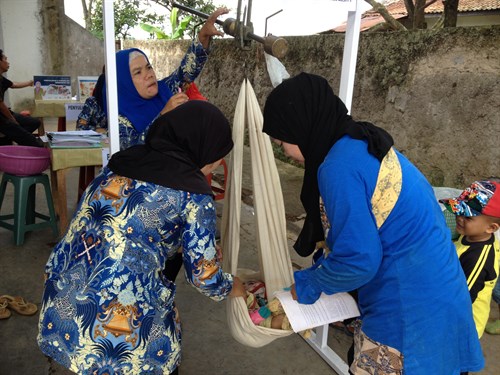
By Sudirman Nasir
This article was first published in the Jakarta Post.
Four days before the commemoration of Kartini Day on April 21, as a researcher I attended a village health community (Posyandu) session in a village in Cianjur, West Java. A village midwife and four volunteers were busy organizing activities such as providing iron tablets and health information for pregnant women, as well as weighing and giving additional nutritious food for infants.
Kartini, our heroine of women’s rights in Indonesia, would be surely proud of such unsung heroes, the highly motivated health workers. Without them our maternal and child deaths would be much higher.
Kartini herself died before she turned 25 years old, after giving birth to her first son in 1904. Over a century later, despite great advances in medical and public health sciences, many young Indonesian women still face a similar fate.
According to the World Health Organization (WHO) maternal mortality is the death of a woman while pregnant or within 42 days of termination of pregnancy, irrespective of the duration and the site of the pregnancy, from any cause related to or aggravated by the pregnancy or its management, but not from accidental or incidental causes.
Our maternal mortality rate is still the highest in Southeast Asia, at 359 maternal deaths per 100,000 live births. Our efforts to materialize the Millennium Development Goals’ target of a maternal mortality rate of 102 per 100,000 live births by 2015 seem very distant.
Several studies in Indonesia and other developing countries have shown numerous biomedical issues contributing to the high rate of maternal deaths such as post-delivery bleeding, infection, high blood pressure and obstructed labor, made worse by the poor quality of emergency obstetric services, poorly organized referral systems and human resource distribution particularly in rural areas.
Further, maternal deaths in Indonesia mostly occur among mothers who give birth at home without skilled birth attendants. Though more women have deliveries in health facilities, it is not as high as expected.
Our current study in the regencies of Cianjur, West Java, and Southwest Sumban East Nusa Tenggara, confirm numerous social, economic and cultural barriers that may hinder pregnant mothers from delivering at health facilities.
These barriers include distance, poor road conditions, lack of availability of transportation (including transportation costs), as well as cost of accommodation and food for family members accompanying the patient to health facilities.
Furthermore, many may lack access to a midwife. Many midwives do not reside in their assigned village, due to limited supporting facilities and family reasons, or difficulties in contacting the midwife due to distance and lack of communication tools.
Our findings also revealed that women and families tended not to have deliveries at health facilities owing to poor perception of benefits of delivery at health facilities and preference for home delivery and traditional birth attendants.
Further, the traditional attendants rarely referred pregnant women to midwives, with whom they had little communication. The traditional attendants mostly live near to the pregnant women compared to the midwives.
The traditional attendants also provide psychological and cultural support such as massages, herbal medicine and recitation of specific prayers that are perceived as valuable services by the families and communities.
Our study also found that compared to other villages in Cianjur and Southwest Sumba, several villages in both regencies had higher attendance of antenatal care to check pregnancy progress, as well as higher levels of delivery at health facilities. The better performance and enthusiasm of village midwives and Posyandu volunteers, and support from important stakeholders such as the heads of the villages, hamlets, neighborhoods and other leaders including those from the local Family Welfare Movement (PKK) is crucial in achieving better maternal health indicators.
Unfortunately, the support of these important stakeholders is not systematically created. These villages are merely lucky to have these proactive stakeholders, with no guarantee of sustainable support when their tenure ends.
Therefore we should remember another pioneer of women’s rights and women’s health — the late Kardinah Soepardjo Roestam who died in 2012. Kardinah, the wife of the late Soepardjo Roestam, a home minister in the 1980s, played a key role in developing Posyandu and encouraging its volunteers to support pregnant mothers and women’s health programs in villages across the archipelago.
She was also tireless in encouraging regents, village heads and the wives of such officials to support the community health centers and maternal health programs. Because of her role, she received the prestigious Sasakawa health prize from the WHO in 1989.
We hope to have a new prominent maternal health advocate such as Kardinah. We also hope the First Lady, First Lady Iriana, Coordinating Human Development and Culture Minister Puan Maharani or Social Affairs Minister Khofifah Indar Parawansa will jump to this strategic role.
Photograph by Olivia Tulloch.
Recent news
- REACHOUT contributes to Ebola enquiry, 27 April 2015
- Implications of the community health policy change in Kenya in light of world health worker week #WHWWeek, 10 April 2015
- REACHOUT quality improvement cycle in Indonesia: Our work in pictures, 9 April 2015

This project is funded by the European Union.
